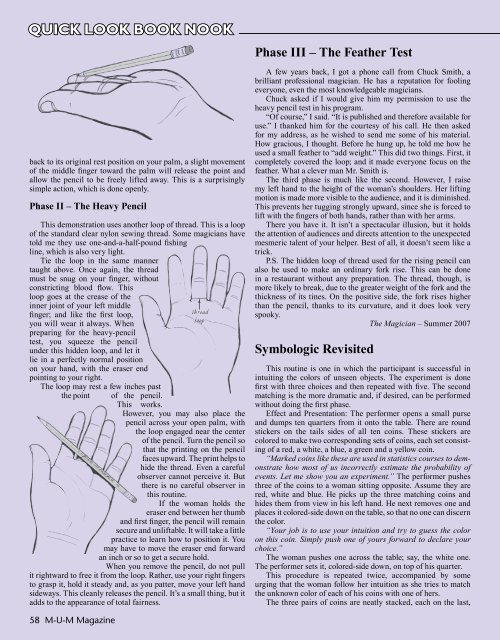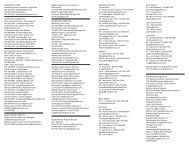(Hank) Moorehouse 1934 – 2011 - The Society of American Magicians
(Hank) Moorehouse 1934 – 2011 - The Society of American Magicians
(Hank) Moorehouse 1934 – 2011 - The Society of American Magicians
Create successful ePaper yourself
Turn your PDF publications into a flip-book with our unique Google optimized e-Paper software.
QUICK LooK BooK NooK<br />
back to its original rest position on your palm, a slight movement<br />
<strong>of</strong> the middle finger toward the palm will release the point and<br />
allow the pencil to be freely lifted away. This is a surprisingly<br />
simple action, which is done openly.<br />
Phase ii <strong>–</strong> the heavy Pencil<br />
This demonstration uses another loop <strong>of</strong> thread. This is a loop<br />
<strong>of</strong> the standard clear nylon sewing thread. Some magicians have<br />
told me they use one-and-a-half-pound fishing<br />
line, which is also very light.<br />
Tie the loop in the same manner<br />
taught above. Once again, the thread<br />
must be snug on your finger, without<br />
constricting blood flow. This<br />
loop goes at the crease <strong>of</strong> the<br />
inner joint <strong>of</strong> your left middle<br />
finger; and like the first loop,<br />
you will wear it always. When<br />
preparing for the heavy-pencil<br />
test, you squeeze the pencil<br />
under this hidden loop, and let it<br />
lie in a perfectly normal position<br />
on your hand, with the eraser end<br />
pointing to your right.<br />
<strong>The</strong> loop may rest a few inches past<br />
the point <strong>of</strong> the pencil.<br />
This works.<br />
However, you may also place the<br />
pencil across your open palm, with<br />
the loop engaged near the center<br />
<strong>of</strong> the pencil. Turn the pencil so<br />
that the printing on the pencil<br />
faces upward. <strong>The</strong> print helps to<br />
hide the thread. Even a careful<br />
observer cannot perceive it. But<br />
there is no careful observer in<br />
this routine.<br />
If the woman holds the<br />
eraser end between her thumb<br />
and first finger, the pencil will remain<br />
secure and unliftable. It will take a little<br />
practice to learn how to position it. You<br />
may have to move the eraser end forward<br />
an inch or so to get a secure hold.<br />
When you remove the pencil, do not pull<br />
it rightward to free it from the loop. Rather, use your right fingers<br />
to grasp it, hold it steady and, as you patter, move your left hand<br />
sideways. This cleanly releases the pencil. It’s a small thing, but it<br />
adds to the appearance <strong>of</strong> total fairness.<br />
58 M-U-M Magazine<br />
Phase iii <strong>–</strong> the feather test<br />
A few years back, I got a phone call from Chuck Smith, a<br />
brilliant pr<strong>of</strong>essional magician. He has a reputation for fooling<br />
everyone, even the most knowledgeable magicians.<br />
Chuck asked if I would give him my permission to use the<br />
heavy pencil test in his program.<br />
“Of course,” I said. “It is published and therefore available for<br />
use.” I thanked him for the courtesy <strong>of</strong> his call. He then asked<br />
for my address, as he wished to send me some <strong>of</strong> his material.<br />
How gracious, I thought. Before he hung up, he told me how he<br />
used a small feather to “add weight.” This did two things. First, it<br />
completely covered the loop; and it made everyone focus on the<br />
feather. What a clever man Mr. Smith is.<br />
<strong>The</strong> third phase is much like the second. However, I raise<br />
my left hand to the height <strong>of</strong> the woman’s shoulders. Her lifting<br />
motion is made more visible to the audience, and it is diminished.<br />
This prevents her tugging strongly upward, since she is forced to<br />
lift with the fingers <strong>of</strong> both hands, rather than with her arms.<br />
<strong>The</strong>re you have it. It isn’t a spectacular illusion, but it holds<br />
the attention <strong>of</strong> audiences and directs attention to the unexpected<br />
mesmeric talent <strong>of</strong> your helper. Best <strong>of</strong> all, it doesn’t seem like a<br />
trick.<br />
P.S. <strong>The</strong> hidden loop <strong>of</strong> thread used for the rising pencil can<br />
also be used to make an ordinary fork rise. This can be done<br />
in a restaurant without any preparation. <strong>The</strong> thread, though, is<br />
more likely to break, due to the greater weight <strong>of</strong> the fork and the<br />
thickness <strong>of</strong> its tines. On the positive side, the fork rises higher<br />
than the pencil, thanks to its curvature, and it does look very<br />
spooky.<br />
<strong>The</strong> Magician <strong>–</strong> Summer 2007<br />
symbologic revisited<br />
This routine is one in which the participant is successful in<br />
intuiting the colors <strong>of</strong> unseen objects. <strong>The</strong> experiment is done<br />
first with three choices and then repeated with five. <strong>The</strong> second<br />
matching is the more dramatic and, if desired, can be performed<br />
without doing the first phase.<br />
Effect and Presentation: <strong>The</strong> performer opens a small purse<br />
and dumps ten quarters from it onto the table. <strong>The</strong>re are round<br />
stickers on the tails sides <strong>of</strong> all ten coins. <strong>The</strong>se stickers are<br />
colored to make two corresponding sets <strong>of</strong> coins, each set consisting<br />
<strong>of</strong> a red, a white, a blue, a green and a yellow coin.<br />
“Marked coins like these are used in statistics courses to demonstrate<br />
how most <strong>of</strong> us incorrectly estimate the probability <strong>of</strong><br />
events. Let me show you an experiment.” <strong>The</strong> performer pushes<br />
three <strong>of</strong> the coins to a woman sitting opposite. Assume they are<br />
red, white and blue. He picks up the three matching coins and<br />
hides them from view in his left hand. He next removes one and<br />
places it colored-side down on the table, so that no one can discern<br />
the color.<br />
“Your job is to use your intuition and try to guess the color<br />
on this coin. Simply push one <strong>of</strong> yours forward to declare your<br />
choice.”<br />
<strong>The</strong> woman pushes one across the table; say, the white one.<br />
<strong>The</strong> performer sets it, colored-side down, on top <strong>of</strong> his quarter.<br />
This procedure is repeated twice, accompanied by some<br />
urging that the woman follow her intuition as she tries to match<br />
the unknown color <strong>of</strong> each <strong>of</strong> his coins with one <strong>of</strong> hers.<br />
<strong>The</strong> three pairs <strong>of</strong> coins are neatly stacked, each on the last,



